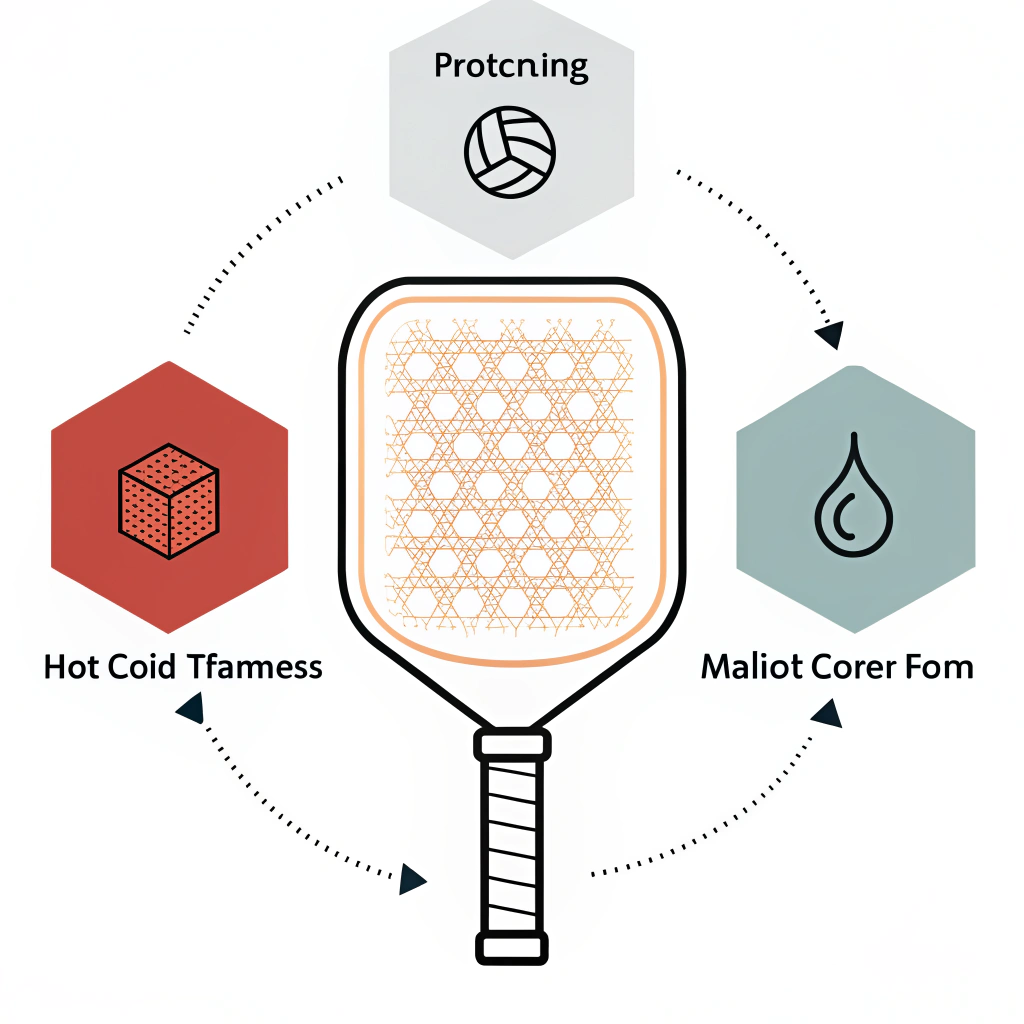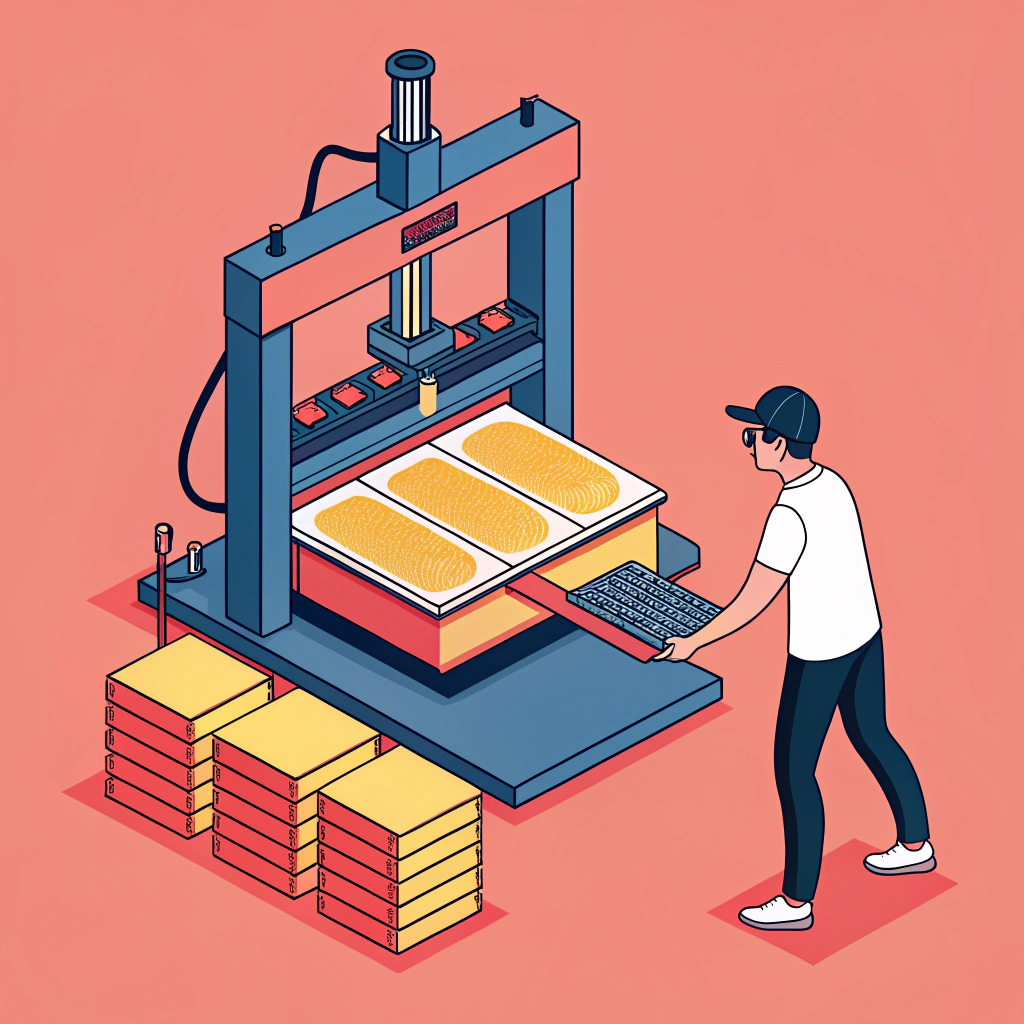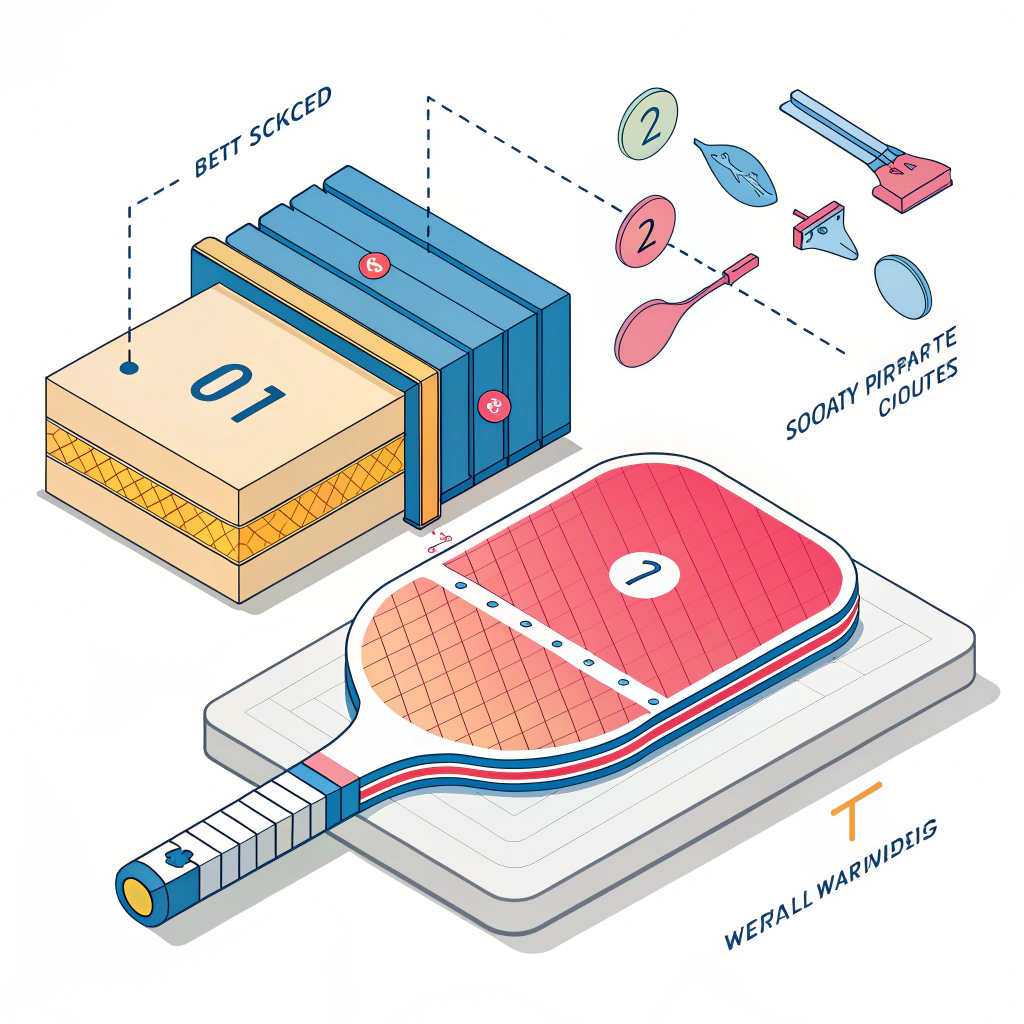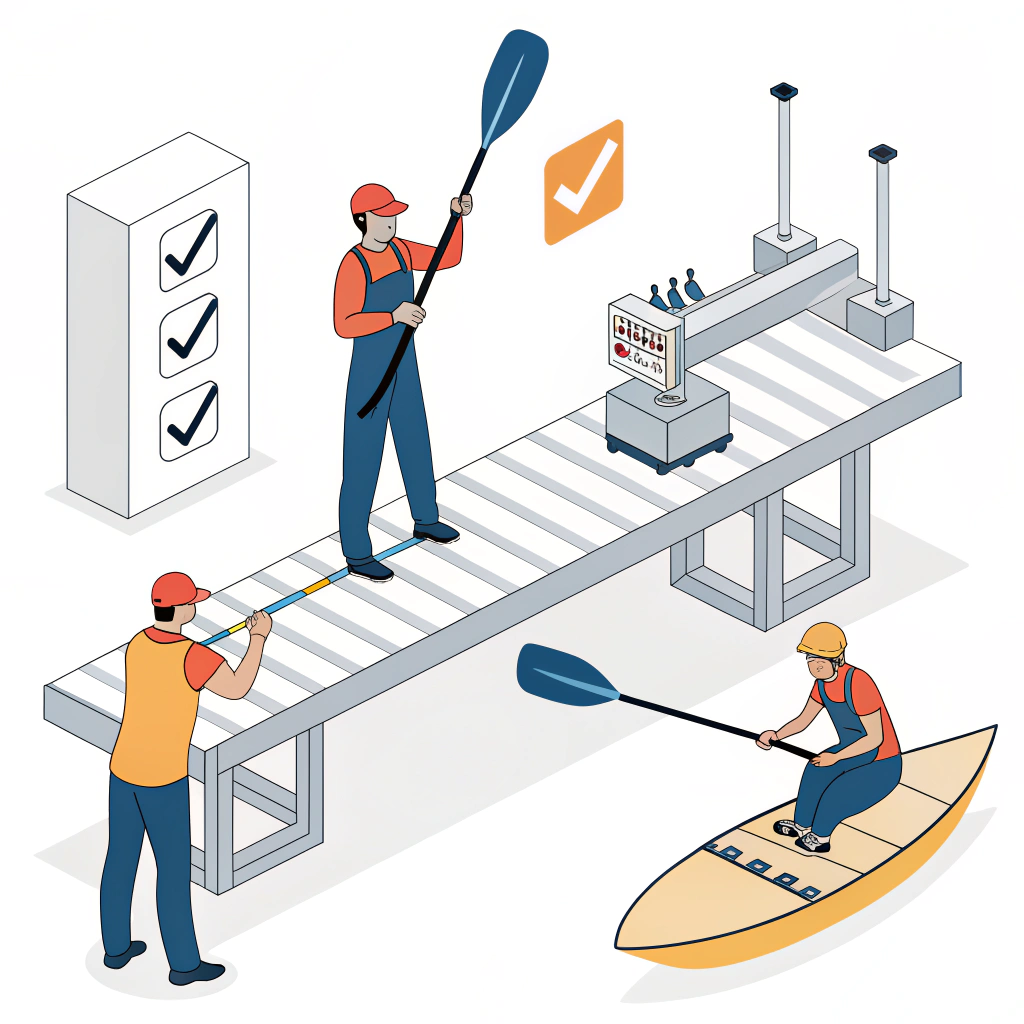In pickleball paddle manufacturing, production processes such as hot pressing1, cold pressing2, and thermoforming3 critically shape the paddle’s performance, quality, and consistency. These techniques, when combined with advanced materials like carbon fiber4, fiberglass, and premium core materials, ensure that each paddle meets the high demands of performance and durability expected in modern competitive play.
Our manufacturing overview begins with recognizing the challenge: creating a paddle that balances strength with responsiveness, durability with precise ball control. Manufacturers and sourcing managers face the dual challenge of achieving consistent production quality while optimizing assembly efficiency. The technical intricacies involved in each production step influence not only the paddle’s quality but also its market competitiveness.
High-performance pickleball paddles are crafted using advanced production techniques. Below, we examine the three primary processes:
-
Hot Pressing
Hot pressing is a process where materials are heated and then pressed under high pressure. This method is commonly used in high-volume manufacturing environments where efficiency and consistent structural integrity are critical.
-
Advantages:
- Accelerates production efficiency for large-scale orders.
- Enhances the paddle’s impact resistance and overall strength.
- Ensures a robust bond between layers through consistent heat application.
-
Disadvantages:
- High initial investment due to sophisticated equipment.
- Some material properties may change during the heating process, potentially altering the paddle’s feel.
- Less flexibility in design modifications once set on the production line.
-
Advantages:
-
Cold Pressing
Cold pressing shapes the paddle material at ambient temperature under mechanical pressure. This process appeals where precise control over the paddle’s thickness and internal structure is paramount.
-
Advantages:
- Maintains the original properties of the materials, preserving optimal ball feel and control.
- Offers a higher degree of accuracy in thickness and material distribution.
- Ideal for customized designs where precise control is essential.
-
Disadvantages:
- Production cycles can be longer, making it less efficient for high-volume manufacturing.
- Demands highly controlled pressure application to avoid inconsistencies.
- May be more labor-intensive compared to hot pressing.
-
Advantages:
-
Thermoforming
Thermoforming uses heat to soften the material, which is then shaped using customized molds. This technique is especially effective for paddles with intricate designs and where precise material distribution is needed.
-
Advantages:
- Allows for complex structural designs and precise material distribution.
- Maintains high stability throughout the paddle, which enhances overall performance.
- Suits a wide range of high-performance materials for a premium product finish.
-
Disadvantages:
- Requires longer production times because the process involves heating, molding, and cooling.
- Generally incurs higher equipment costs, which can be a factor for smaller production runs.
- Best suited to premium products rather than standard models.
-
Advantages:
To aid decision-making, consider the following table summarizing the key aspects of each process:
| Production Process | Key Benefits | Primary Drawbacks | Best For |
|---|---|---|---|
| Hot Pressing | High efficiency; strong impact resistance | Altered material properties; high equipment cost | Large-scale, durable production |
| Cold Pressing | Precise control; maintains material properties | Longer cycle time; precision required | Customized design and high-quality ball feel |
| Thermoforming | Intricate design; accurate material distribution | Higher costs; slower production cycle | Premium, custom-made paddles |
Each method plays a distinct role within the manufacturing ecosystem. A comprehensive balance between performance requirements and production efficiency often leads to the integration of multiple techniques. In some cases, hybrid methods—combining aspects of both cold pressing and thermoforming—enable customization while preserving production efficiency.
In addition to the production process, the choice of materials is a fundamental factor in the overall quality of pickleball paddles. At NEX Pickleball, the raw materials are chosen carefully for both performance and durability:
-
Carbon Fiber Variants:
- 3K Carbon Fiber: Provides a balance between strength and flexibility, ideal for paddles that demand high rebound force and reduced vibration.
- 12K Carbon Fiber: Offers greater hardness with a smoother surface, enhancing durability for competitive play.
- T300 Carbon Fiber: Known for its overall balance of tensile strength and lightweight qualities, making it versatile for high-performance applications.
-
Fiberglass Options:
- E-Glass Fiberglass: Offers excellent elasticity and tensile strength, which improves ball control and power balance.
-
Composite Materials:
- Carbon Fiber and Fiberglass Composite: Merges the benefits of both composite materials to bring forth an ideal blend of strength, lightness, and flexibility.
- Bamboo Core Composite: Not only lightweight but also highly resistant to impact, offering a clear hitting feel that suits long-lasting play.
- Honeycomb Core: Manufactured from high-density polymers, it provides superior shock absorption and vibration reduction during play.
-
Core Options:
- Nomex Honeycomb Core5: Ideal for long-term durability and stability due to its excellent shock absorption.
- Aluminum Honeycomb Core: Strikes a balance between power and control, preferred by players requiring both precision and strength.
- Polymer Honeycomb Core: Favoured by recreational players for its elasticity and reduced vibration, offering enhanced comfort.
It is essential to align the selection of raw materials with the chosen production process. For instance, when using thermoforming to create a paddle design with intricate curves, premium materials like T300 Carbon Fiber or a hybrid composite might be recommended to ensure the final product meets the rigorous demands of high-level performance.
Consistent quality is non-negotiable in B2B manufacturing. Each paddle undergoes rigorous testing to confirm its structural integrity, balance, and responsiveness. Key quality control measures include:
- Precision Engineering: Each paddle is produced with strict adherence to dimensional tolerances. Technologies such as digital pressure sensors and automated inspection systems are employed to ensure consistency across batches.
- Ergonomic Testing: Paddle grip size and surface texturing are meticulously designed to fit the diverse hand sizes of players. This ergonomic attention not only reduces player fatigue but also enhances control and shot accuracy.
- Real-World Testing: Before large-scale production, prototypes are put through intense field tests by professional athletes. Feedback on paddle performance under different pressure scenarios is integral to refining both the production process and material selection.
Looking at the interplay of production techniques and material properties, it becomes clear that slight variations at the manufacturing stage can significantly affect the end performance of the paddle. As such, it is crucial for sourcing managers and production specialists to collaborate closely with manufacturers like us to align specifications with real-world performance objectives.
For sourcing managers interested in optimizing assembly lines or selecting the right supplier, consider these factors:
-
Integration of Multiple Techniques:
Combining hot pressing for structural strength with cold pressing for precision control allows manufacturers to push the limits of both durability and game performance. Evaluating the supplier’s ability to integrate multiple production techniques is a mark of a robust manufacturing process. -
Equipment and Automation:
Investments in automation—ranging from precision pressure controls to automated inspection systems—directly correlate with the consistency and repeatability of paddle performance. For larger orders, streamlined production with minimal deviation is vital. -
Customization Capabilities:
The ability to offer custom designs in terms of weight distribution, grip design, and material mix adds considerable value in competitive sports markets. Suppliers that offer on-demand print services or tailored paddle specifications provide a strategic advantage in branding and market differentiation. -
Production Scalability and Cost Efficiency:
The choice of production process can affect scalability. For instance, while hot pressing is highly efficient for mass production, it might lack the customization capabilities of thermoforming. Understanding the trade-offs between cost, efficiency, and customization helps in making informed sourcing decisions. -
Post-Production Quality Assurance:
Quality control is essential. A comprehensive testing regimen that includes both laboratory tests and real-field trials assures that each paddle produced meets industry standards for high-performance sports equipment.
In conclusion, the manufacturing process of pickleball paddles is a sophisticated combination of material science, precision engineering, and advanced production techniques. Here are the key takeaways:
- Hot Pressing is ideal for high-volume orders requiring robust impact resistance but carries a higher equipment cost and potential material alteration.
- Cold Pressing allows for precise material handling and superior ball feel, making it suitable for custom and high-quality designs, albeit with a slower production cycle.
- Thermoforming provides exceptional design flexibility for premium products, though it requires increased production time and higher initial costs.
- Material selection, including various types of carbon fiber, fiberglass, and advanced core materials, plays a crucial role in determining the paddle’s performance characteristics.
- Consistent quality control, robust testing mechanisms, and ergonomic design innovations are non-negotiable in delivering a product that meets market demands.
For manufacturing or sourcing managers assessing suppliers, understanding these processes can significantly influence product reliability and market success. It is recommended to engage with suppliers who transparently share their production processes and quality assurance practices. If you are considering improvements in your production line or wish to source paddles that offer both performance and durability, deep-diving into the specifics of each production process and material choice is essential.
By integrating state-of-the-art production methods with rigorous quality control protocols, businesses can greatly enhance their competitive position in the sports equipment market.
People Also Ask
Q1: What is the best manufacturing process for pickleball paddles?
A1: The best manufacturing process depends on production goals. Hot pressing offers efficient mass production with strong impact resistance, while cold pressing provides precise control over material properties. Thermoforming is ideal for premium, custom designs that require intricate detailing.
Q2: How does hot pressing affect the durability of paddles?
A2: Hot pressing enhances a paddle’s durability by using high heat and pressure to form strong bonds between materials. Although it may slightly alter material properties, the process results in a product with excellent impact resistance suitable for high-performance play.
Q3: What advantages does thermoforming offer in paddle production?
A3: Thermoforming allows for precise shaping and design flexibility. It enables manufacturers to create paddles with complex geometries and tailored material distribution, which in turn enhances stability and performance in premium models.
-
hot pressing: Read more to understand how applying heat and pressure in a controlled environment enhances the structural integrity of composite materials during high-volume production. ↩
-
cold pressing: Explore the detailed methodology behind cold pressing, which preserves the original material properties and allows for refined thickness control in precision manufacturing. ↩
-
thermoforming: Learn about thermoforming, a process that uses heat to enable intricate design and complex shaping, ideal for premium product finishes in competitive manufacturing. ↩
-
carbon fiber: Delve into the properties of carbon fiber, a high-strength, lightweight material crucial for enhancing performance and durability in advanced sporting goods. ↩
-
Nomex Honeycomb Core: Discover how Nomex Honeycomb Core technology delivers superior shock absorption and long-term stability, making it a preferred choice in high-performance paddle construction. ↩







